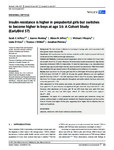Insulin resistance is higher in prepubertal girls but switches to become higher in boys at age 16: A Cohort Study (EarlyBird 57)
| dc.contributor.author | Jeffery, SC | |
| dc.contributor.author | Hosking, Joanne | |
| dc.contributor.author | Jeffery, Alison | |
| dc.contributor.author | Murphy, MJ | |
| dc.contributor.author | Voss, LD | |
| dc.contributor.author | Wilkin, TJ | |
| dc.contributor.author | Pinkney, Jonathan | |
| dc.date.accessioned | 2018-03-27T12:54:07Z | |
| dc.date.issued | 2018-03 | |
| dc.identifier.issn | 1399-543X | |
| dc.identifier.issn | 1399-5448 | |
| dc.identifier.uri | http://hdl.handle.net/10026.1/11187 | |
| dc.description.abstract |
BACKGROUND: The risk of type 2 diabetes is increasing in teenage girls, and is associated with their greater insulin resistance (IR). HYPOTHESIS: We hypothesized that the adverse metabolic profile of girls (compared with boys) would persist from childhood through adolescence. PATIENTS AND METHODS: Community-based longitudinal cohort of 292 children (147 boys) studied annually from 9 to 16 years. MEASURES: IR (homeostasis-model-assessment-2), high-density lipoprotein-cholesterol (HDL-C), triglycerides, % body-fat (dual-energy x-ray absorptiometry), pubertal stage (age at peak height velocity), physical activity (accelerometry). Multi-level modelling established the age-related trends in IR and lipids and the influence of covariates. RESULTS: Each year from 9 to 15 years, girls had 21% to 63% higher IR than boys (girls mean IR 0.73-1.33, boys 0.51-0.89, P < .005). At 16 years the gender difference was not significant (girls IR 0.60, boys 0.56, P = .45). Girls had lower HDL-C from 9 to 12 years, higher triglycerides from 9 to 14 years, greater adiposity throughout, and earlier puberty, but boys were more active than girls (all P < .05). After adjustment for %-fat, puberty and activity, the gender difference in IR between girls and boys aged 9 to 15 years became non-significant (IR girls 0.66-1.01, boys 0.65-1.04, P > .07). However, after adjustment at 16 years, girls' IR was 25% lower than boys' (girls 0.44, boys 0.63, P = .001), and they had 22% higher HDL-C (P < .001) and 20% lower triglycerides (P = .003). CONCLUSIONS: The higher IR of prepubertal and early pubertal girls diminishes during late puberty, and boys begin to exhibit greater metabolic risk. Despite being leaner and more active, boys at 16 years have higher IR than girls, suggesting future higher risk for diabetes, thus we reject our hypothesis. | |
| dc.format.extent | 223-230 | |
| dc.format.medium | Print-Electronic | |
| dc.language | en | |
| dc.language.iso | en | |
| dc.publisher | Wiley | |
| dc.subject | adiposity | |
| dc.subject | adolescent | |
| dc.subject | child | |
| dc.subject | insulin resistance | |
| dc.subject | physical activity | |
| dc.title | Insulin resistance is higher in prepubertal girls but switches to become higher in boys at age 16: A Cohort Study (EarlyBird 57) | |
| dc.type | journal-article | |
| dc.type | Journal Article | |
| plymouth.author-url | https://www.webofscience.com/api/gateway?GWVersion=2&SrcApp=PARTNER_APP&SrcAuth=LinksAMR&KeyUT=WOS:000425109500006&DestLinkType=FullRecord&DestApp=ALL_WOS&UsrCustomerID=11bb513d99f797142bcfeffcc58ea008 | |
| plymouth.issue | 2 | |
| plymouth.volume | 19 | |
| plymouth.publication-status | Published | |
| plymouth.journal | Pediatric Diabetes | |
| dc.identifier.doi | 10.1111/pedi.12571 | |
| plymouth.organisational-group | /Plymouth | |
| plymouth.organisational-group | /Plymouth/Faculty of Health | |
| plymouth.organisational-group | /Plymouth/Faculty of Health/Peninsula Medical School | |
| plymouth.organisational-group | /Plymouth/REF 2021 Researchers by UoA | |
| plymouth.organisational-group | /Plymouth/REF 2021 Researchers by UoA/UoA03 Allied Health Professions, Dentistry, Nursing and Pharmacy | |
| plymouth.organisational-group | /Plymouth/Research Groups | |
| plymouth.organisational-group | /Plymouth/Research Groups/FoH - Community and Primary Care | |
| plymouth.organisational-group | /Plymouth/Research Groups/Institute of Health and Community | |
| plymouth.organisational-group | /Plymouth/Research Groups/Institute of Translational and Stratified Medicine (ITSMED) | |
| plymouth.organisational-group | /Plymouth/Research Groups/Institute of Translational and Stratified Medicine (ITSMED)/CBBB | |
| plymouth.organisational-group | /Plymouth/Research Groups/Institute of Translational and Stratified Medicine (ITSMED)/CCT&PS | |
| plymouth.organisational-group | /Plymouth/Research Groups/Plymouth Institute of Health and Care Research (PIHR) | |
| plymouth.organisational-group | /Plymouth/Users by role | |
| plymouth.organisational-group | /Plymouth/Users by role/Academics | |
| dc.publisher.place | Denmark | |
| dcterms.dateAccepted | 2017-07-21 | |
| dc.rights.embargodate | 2018-8-29 | |
| dc.identifier.eissn | 1399-5448 | |
| dc.rights.embargoperiod | No embargo | |
| rioxxterms.versionofrecord | 10.1111/pedi.12571 | |
| rioxxterms.licenseref.uri | http://www.rioxx.net/licenses/all-rights-reserved | |
| rioxxterms.licenseref.startdate | 2018-03 | |
| rioxxterms.type | Journal Article/Review |


